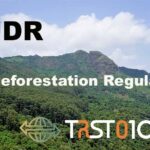About Footprint by TRST01
The ‘Footprint by TRST01’ is an essential solution that provides users with clear, concise, and comprehensive information for ESG assessment. Utilizing data science and machine learning, it evaluates a company’s digital readiness, making it an advanced and unique solution. The FAQs serve as a crucial resource for businesses, investors, and stakeholders to gain a better understanding of the application and usefulness of ‘Footprint by TRST01.’ By utilizing the FAQs, accurate and up-to-date ESG performance assessments are made easier.
What is Footprint by TRST01?
Footprint by TRST01 is an innovative solution that utilizes AI and blockchain technology to revolutionize ESG (Environmental, Social, and Governance) tracking, measurement, and reporting.
How does Footprint by TRST01 adhere to global ESG standards?
Footprint by TRST01 is designed to comply with the standards of global ESG frameworks such as the Global Reporting Initiative (GRI), Business Responsibility and Sustainability Reporting (BRSR) India, Sustainability Accounting Standards Board (SASB), Task Force on Climate-related Financial Disclosures (TCFD), and Carbon Disclosure Project (CDP). This ensures that businesses can create credible and comparable ESG disclosures on a global scale.
Can Footprint by TRST01 help in aligning operations with the UNSDGs?
Yes, Footprint by TRST01 integrates the United Nations Sustainable Development Goals (UNSDGs) into the ESG reporting framework, allowing businesses to track their contributions to these globally recognized targets.
Does Footprint by TRST01 offer industry-specific solutions?
Yes, Footprint by TRST01 offers tailored content that caters to the unique ESG needs and concerns of each industry. This allows companies to focus on the most relevant ESG issues pertaining to their operations.
How can businesses benefit from TRST01's solutions ?
Businesses can benefit from TRST01’s solutions by gaining transparency and traceability in their supply chains, automating ESG reporting processes, and accessing reliable data for informed decision-making. These solutions promote sustainability, trust, and accountability in business operations.
How does Footprint by TRST01 handle supply chain management reporting?
Footprint by TRST01 uses blockchain technology, a decentralized and immutable system, to guarantee that all ESG data recorded is accurate and has not been tampered with. This enhances the reliability and transparency of ESG data.
How does blockchain technology enhance the reliability of Footprint by TRST01?
Footprint by TRST01 uses blockchain technology, a decentralized and immutable system, to guarantee that all ESG data recorded is accurate and has not been tampered with. This enhances the reliability and transparency of ESG data.
How does Footprint by TRST01 assist with India's BRSR reporting requirements?
Footprint by TRST01 provides an automated and standardized process for Business Responsibility and Sustainability Reporting (BRSR) in India. It enables companies to efficiently collect, analyze, and report ESG data in compliance with the new ESG reporting requirements set by the Securities and Exchange Board of India (SEBI).
How can Footprint by TRST01 contribute to a more sustainable future?
By providing an industry-specific, customizable solution that prioritizes transparency and trust, Footprint by TRST01 can help companies take a holistic view of their operations, enhance their reputation, gain stakeholder trust, and ultimately contribute to a more sustainable future for all.
What is the ESG Scorecard Model?
The ESG Scorecard Model is a tool designed to assess an organization’s performance based on environmental, social, and governance parameters. It helps in identifying potential ESG risks and is a robust performance indicator.
What are the benefits of using the ESG Scorecard Model?
The ESG Scorecard Model helps in identifying potential environmental, social, and governance risks that could affect a company’s financial performance or reputation. It serves as a performance indicator, helps in communicating a company’s dedication to sustainability, and shows compliance with stricter ESG regulations.
How does the ESG Scorecard Model differ from ESG Ratings?
The Scorecard Model provides a detailed quantitative analysis of a company’s ESG performance, utilizing specific metrics, while ESG Ratings provide a more generalized, qualitative assessment of a company’s ESG practices.
What are some limitations of the ESG Scorecard Model?
Lack of standardization and possible subjectivity in evaluations can lead to biases and discrepancies in ESG Scorecard Models. Also, high scores do not always indicate a positive impact as self-reported ESG data can be inconsistent or inaccurate.
What role does industry-specific and country-specific risk play in ESG Scorecard Modelling?
These risks are essential for creating a comprehensive ESG Scorecard Model. They account for differences in environmental, social, and governance risks faced by companies in different sectors and regions.
How can businesses incorporate the ESG Scorecard Model into their strategy?
The ESG Scorecard Model can be used by businesses to understand potential risks and opportunities, make more informed strategic decisions, drive operational changes, and enhance their reputation.
What makes the Footprint ESG Scorecard by TRST01 unique?
The Footprint ESG Scorecard by TRST01 integrates advanced analytics, machine learning algorithms, and big data to comprehensively assess a company’s ESG performance. It also introduces a ‘fourth dimension’ – Technological Impact, considering the ethical implications of technology and a company’s readiness for digital transformation.
What impact does the ESG Scorecard Model have on investors?
For investors, the ESG Scorecard Model provides a detailed analysis of a company’s ESG performance, which can help in identifying potential risks and opportunities, thus enabling informed investment decisions.
Featured posts
-
Blockchain for Sustainability
June 14, 2024 -
EUDR Coffee : Between the Cup and the Lip
June 9, 2024 -
EUDR and India Rubber Export
May 25, 2024



